新概念一lesson43-48课文及知识点
- 格式:doc
- 大小:32.00 KB
- 文档页数:3
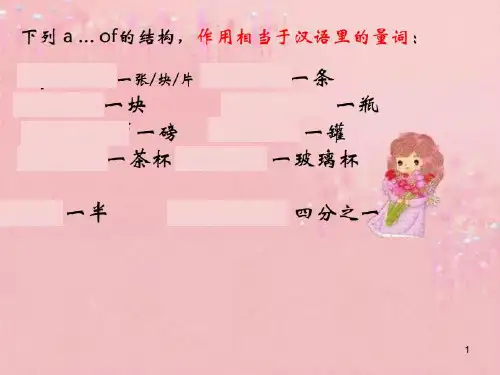
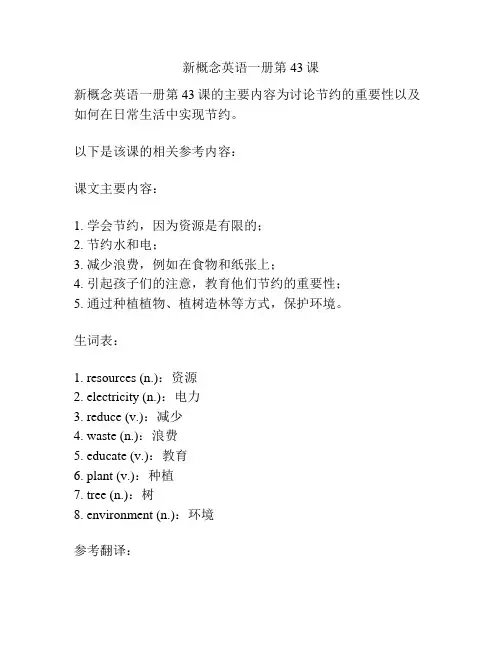
新概念英语一册第43课
新概念英语一册第43课的主要内容为讨论节约的重要性以及如何在日常生活中实现节约。
以下是该课的相关参考内容:
课文主要内容:
1. 学会节约,因为资源是有限的;
2. 节约水和电;
3. 减少浪费,例如在食物和纸张上;
4. 引起孩子们的注意,教育他们节约的重要性;
5. 通过种植植物、植树造林等方式,保护环境。
生词表:
1. resources (n.):资源
2. electricity (n.):电力
3. reduce (v.):减少
4. waste (n.):浪费
5. educate (v.):教育
6. plant (v.):种植
7. tree (n.):树
8. environment (n.):环境
参考翻译:
1. We must learn to economize because resources are limited.
2. We should conserve water and electricity.
3. We need to cut down on waste, such as food and paper.
4. We should draw children's attention to the importance of saving and teach them how to economize.
5. We can protect the environment by planting plants, trees and forestation, etc.。
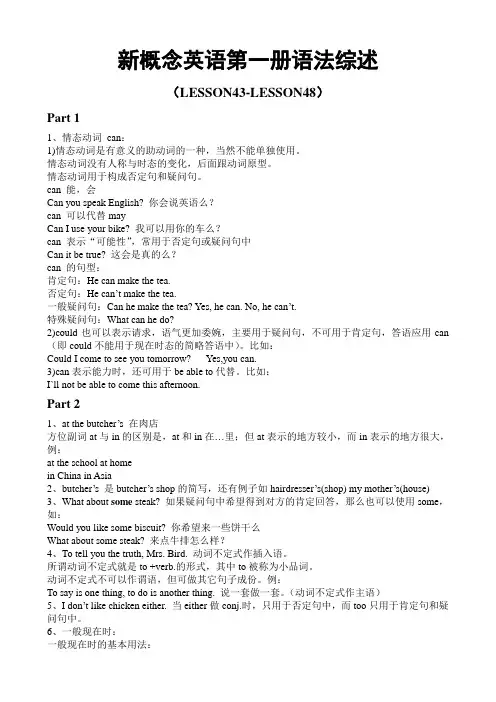
新概念英语第一册语法综述(LESSON43-LESSON48)Part 11、情态动词can:1)情态动词是有意义的助动词的一种,当然不能单独使用。
情态动词没有人称与时态的变化,后面跟动词原型。
情态动词用于构成否定句和疑问句。
can 能,会Can you speak English? 你会说英语么?can 可以代替mayCan I use your bike? 我可以用你的车么?can 表示“可能性”,常用于否定句或疑问句中Can it be true? 这会是真的么?can 的句型:肯定句:He can make the tea.否定句:He can’t make the tea.一般疑问句:Can he make the tea? Yes, he can. No, he can’t.特殊疑问句:What can he do?2)could也可以表示请求,语气更加委婉,主要用于疑问句,不可用于肯定句,答语应用can (即could不能用于现在时态的简略答语中)。
比如:Could I come to see you tomorrow? Yes,you can.3)can表示能力时,还可用于be able to代替。
比如:I`ll not be able to come this afternoon.Part 21、at the butcher’s 在肉店方位副词at与in的区别是,at和in在…里;但at表示的地方较小,而in表示的地方很大,例:at the school at homein China in Asia2、butcher’s 是butcher’s shop的简写,还有例子如hairdresser’s(shop) my mother’s(house)3、What about some steak? 如果疑问句中希望得到对方的肯定回答,那么也可以使用some,如:Would you like some biscuit? 你希望来一些饼干么What about some steak? 来点牛排怎么样?4、To tell you the truth, Mrs. Bird. 动词不定式作插入语。
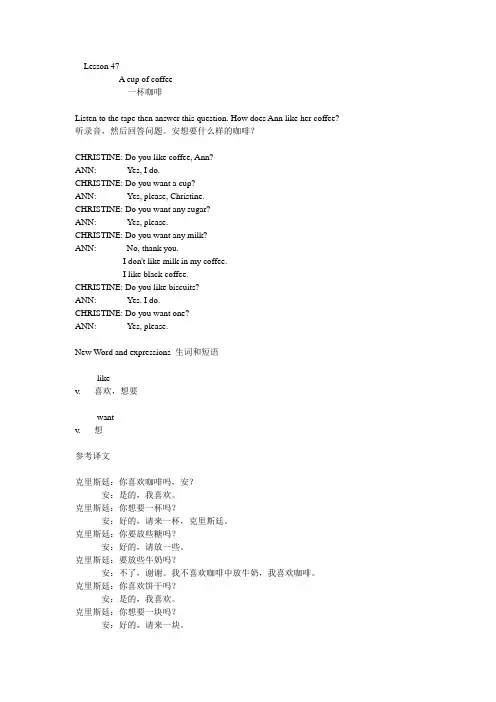
A cup of coffee一杯咖啡Listen to the tape then answer this question. How does Ann like her coffee? 听录音,然后回答问题。
安想要什么样的咖啡?CHRISTINE: Do you like coffee, Ann?ANN: Yes, I do.CHRISTINE: Do you want a cup?ANN: Yes, please, Christine.CHRISTINE: Do you want any sugar?ANN: Yes, please.CHRISTINE: Do you want any milk?ANN: No, thank you.I don't like milk in my coffee.I like black coffee.CHRISTINE: Do you like biscuits?ANN: Yes. I do.CHRISTINE: Do you want one?ANN: Yes, please.New Word and expressions 生词和短语likev. 喜欢,想要wantv. 想参考译文克里斯廷:你喜欢咖啡吗,安?安:是的,我喜欢。
克里斯廷:你想要一杯吗?安:好的,请来一杯,克里斯廷。
克里斯廷:你要放些糖吗?安:好的,请放一些。
克里斯廷:要放些牛奶吗?安:不了,谢谢。
我不喜欢咖啡中放牛奶,我喜欢咖啡。
克里斯廷:你喜欢饼干吗?安:是的,我喜欢。
克里斯廷:你想要一块吗?安:好的,请来一块。
新概念第一册47-48 课文详解及练习答案课文详注Further notes on the text1.Yes, I do. 是的,我喜欢。
是一句肯定的简略回答。
如果是否定的回答,则应为No, I don't. I like…和I don't like…这两个句型是分别表示“我喜欢/想要……”和“我不喜欢/想要……”的惯常用法。
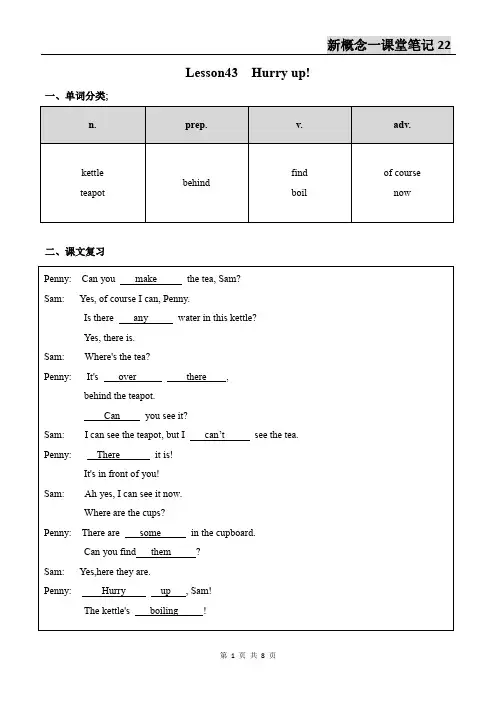
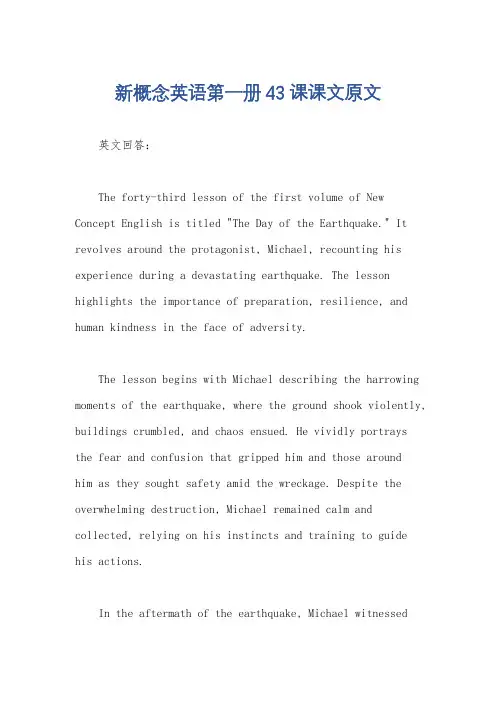
新概念英语第一册43课课文原文英文回答:The forty-third lesson of the first volume of New Concept English is titled "The Day of the Earthquake." It revolves around the protagonist, Michael, recounting his experience during a devastating earthquake. The lesson highlights the importance of preparation, resilience, and human kindness in the face of adversity.The lesson begins with Michael describing the harrowing moments of the earthquake, where the ground shook violently, buildings crumbled, and chaos ensued. He vividly portrays the fear and confusion that gripped him and those aroundhim as they sought safety amid the wreckage. Despite the overwhelming destruction, Michael remained calm and collected, relying on his instincts and training to guidehis actions.In the aftermath of the earthquake, Michael witnessedthe resilience of the human spirit. Ordinary people came together to help one another, searching for survivors, providing medical assistance, and offering comfort to the injured and traumatized. Michael himself played a crucial role in the rescue efforts, using his knowledge and skills to assist the victims.As the days turned into weeks, the community faced the daunting task of rebuilding their lives. Michael and his fellow survivors displayed unwavering determination to overcome the challenges they faced. They worked tirelessly to clear the rubble, establish temporary shelters, and restore essential services.Throughout the ordeal, Michael emphasizes the power of human kindness. Strangers offered food, clothing, and shelter to those who had lost everything. Acts of compassion and empathy provided solace and hope amid the devastation. Michael also acknowledges the importance of international aid, which arrived to support the affected communities in their recovery.The lesson concludes with Michael reflecting on the profound impact the earthquake had on his life. He realized the fragility of human existence and the importance of cherishing every moment. He also gained a deep appreciation for the strength of the human spirit and the resilience of communities that come together in times of need.中文回答:新概念英语第一册第43课课文题为“地震那一天”。

⼀、重要句型或语法 1、情态动词:can 本⾝有⼀定的词义,表⽰语⽓的单词。
但是不能独⽴作谓语,只能和动词原形⼀起构成谓语。
情态动词⽤在⾏为动词前,表⽰说话⼈对这⼀动作或状态的看法或主观设想,如:He can dance./ He can't dance./ Can he dance? Yes, he can. 2、some与any的⽤法:与there be的连⽤ Is there any bread here? Yes, there is. There's some on the table. ⼆、课⽂主要语⾔点 Can you make the tea? make的⽤法可以做回顾拓展,如:make a cake, make coffee, make tea, make the bed等。
Yes, of course I can, Penny. of course相当于第41课中的certainly,表⽰“当然,肯定”。
Is there any water in this kettle? 注意kettle(⽔壶,⽤于烧⽔)和下⽂出现的teapot(茶壶,⽤于泡茶)的区别。
可从合成法⾓度解释teapot,因为它是由tea+pot构成的。
It's over there, behind the teapot. over there表⽰“在那边”,⽤来表⽰离说话者较远的地⽅。
如果较近,可以说“It's right here.”。
behind,可以对⽐复习⼀下in front of和in the front of。
There it is! 表⽰“就在那⼉”,⽤来指出远处的事物。
如果要近指,应该⽤:Here it is! 两者的复数形式分别为:There they are! / Here they are! Can you find them? 注意区分find和look for。
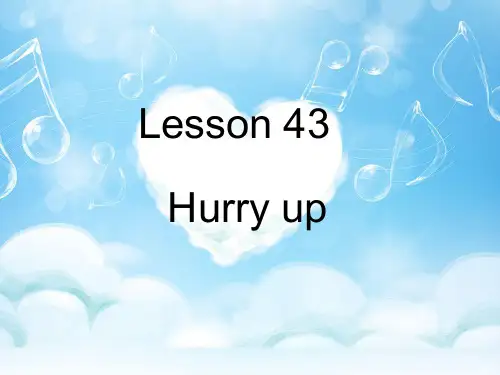
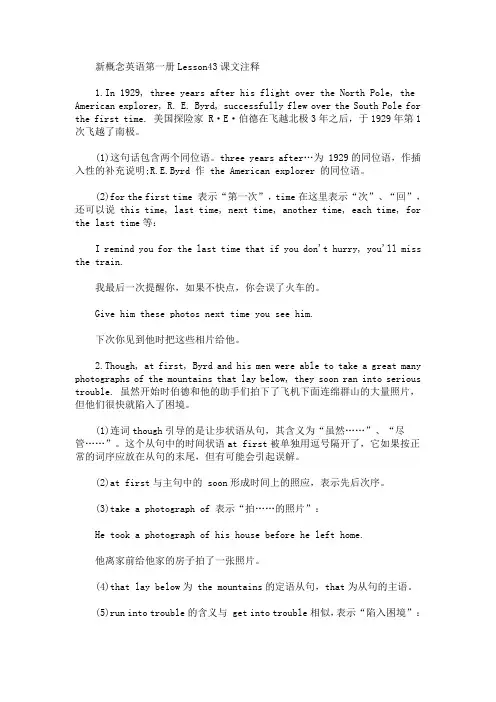
新概念英语第一册Lesson43课文注释1.In 1929, three years after his flight over the North Pole, the American explorer, R. E. Byrd, successfully flew over the South Pole for the first time. 美国探险家R·E·伯德在飞越北极3年之后,于1929年第1次飞越了南极。
(1)这句话包含两个同位语。
three years after…为 1929的同位语,作插入性的补充说明;R.E.Byrd 作 the American explorer 的同位语。
(2)for the first time 表示“第一次”,time在这里表示“次”、“回”,还可以说 this time, last time, next time, another time, each time, for the last time等:I remind you for the last time that if you don't hurry, you'll miss the train.我最后一次提醒你,如果不快点,你会误了火车的。
Give him these photos next time you see him.下次你见到他时把这些相片给他。
2.Though, at first, Byrd and his men were able to take a great many photographs of the mountains that lay below, they soon ran into serious trouble. 虽然开始时伯德和他的助手们拍下了飞机下面连绵群山的大量照片,但他们很快就陷入了困境。
(1)连词though引导的是让步状语从句,其含义为“虽然……”、“尽管……”。
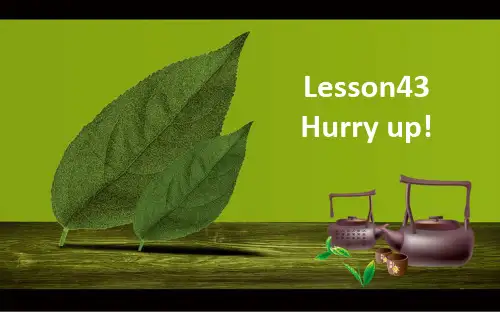

《新概念英语》第一册第43课Hurry up! 快点!【课文】PENNY: Can you make the tea, Sam? SAM: Yes, of course I can, Penny.SAM: Is there any water in this kettle? PENNY: Yes, there is.SAM: Where's the tea?PENNY: It's over there, behind the teapot. PENNY: Can you see it?SAM: I can see the teapot, but I can't see the tea. PENNY: There it is! It's in front of you!SAM: Ah yes, I can see it now.SAM: Where are the cups?PENNY: There are some in the cupboard. PENNY: Can you find them?SAM: Yes. Here they are.PENNY: Hurry up, Sam! The kettle's boil ing! 【课文翻译】彭妮:你会沏茶吗,萨姆?萨姆:会的,我当然会,彭妮。
萨姆:这水壶里有水吗?彭妮:有水。
萨姆:茶叶在哪儿?彭妮:就在那儿,茶壶后面。
彭妮:你看见了吗?萨姆:茶壶我看见了,但茶叶没看到。
彭妮:那不是么!就在你眼前。
萨姆:噢,是啊,我现在看到了。
萨姆:茶杯在哪儿呢?彭妮:碗橱里有几只。
彭妮:你找得到吗?萨姆:找得到。
就在这儿呢。
彭妮:快,萨姆。
水开了!Lesson 45The boss's letter 老板的信THE BOSS: Can you come here a minuteplease, Bob?BOB: Yes, sir?THE BOSS: Where's Pamela?BOB: She's next door.She's in her office, sir.THE BOSS: Can she type this letter for me?Ask her please. BOB: Yes, sir.BOB: Can you type this letter for the boss please, Pamela?PAMELA: Yes, of course I can.BOB: Here you are.PAMELA: Thank you, Bob.PAMELA: Bob!BOB: Yes? What's the matter.PAMELA: I can't type this letter.PAMELA: I can't read it!The boss's handwriting is terrible!参考译文老板:请你来一下好吗?鲍勃?鲍勃: 什么事,先生?老板:帕梅拉在哪儿?鲍勃: 她在隔壁,在她的办公室里,先生。
新概念英语第一册48课讲解(原创实用版)目录一、新概念英语第一册 48 课内容概述二、48 课的主要语法知识点三、48 课的习题答案及解析四、如何学习新概念英语第一册正文一、新概念英语第一册 48 课内容概述新概念英语第一册第 48 课是一篇关于乡村景色的课文,通过描述飞机、轮船、孩子们游泳、猫咪在墙上跑等生动的场景,让学习者感受到乡村生活的美好。
课文中使用了一些常见的生活场景和自然环境描述,有助于学习者掌握日常英语交际用语。
二、48 课的主要语法知识点第 48 课的主要语法知识点包括:1.现在进行时:表示现在正在进行的动作,例如:The aeroplane is flying over the village.(飞机正在飞越村庄。
)2.一般现在时:表示经常或习惯性的动作,例如:The ship goes under the bridge.(轮船穿过桥下。
)3.疑问词和回答:用于询问事物的位置、状态等,例如:- Where are the children? - They are swimming across the river.(孩子们在哪里?——他们在河里游泳。
)4.名词所有格:表示某人或某物的所属关系,例如:Two cats are running along the wall.(两只猫咪正在沿着墙跑。
)三、48 课的习题答案及解析1.问题:What is the aeroplane doing?解答:The aeroplane is flying over the village.2.问题:What is the ship doing?解答:The ship is going under the bridge.3.问题:What are the children doing?解答:The children are swimming across the river.4.问题:What are the cats doing?解答:Two cats are running along the wall.5.问题:What is the boy doing?解答:The boy is jumping off the wall.四、如何学习新概念英语第一册学习新概念英语第一册可以采用以下方法:1.仔细阅读课文,理解课文内容,学习其中的语法知识和词汇。
Lesson 43 Hurry up!【单词讲解】★of course 当然certainly['sɜːtnlɪ]当然(41课)sure 当然★behind 介词,表示空间方位关系在门后面在茶壶后面★kettle and teapotelectric kettleteapot★find sb/sth 找到了。
(强调结果) look for...sb/sth 寻找。
(强调动作)find out 找到,查明事情的真相、原由It is important tofind a hard-working person for the job. find an answer to the questionWe are looking for a pen.But it is not sure we can find it.你正在干嘛?我正在找钥匙我找到了我的汽车★boil v. (水)滚,(水)开,(水)沸腾boil ingThe kettle’s boi lingThe water in the kettle is boi ling【课文讲解】1.Can you make the tea, Sam ?Yes, of course I can, Penny.Can 情态动词,意思是:能。
会。
!make the teamake coffeemake the bedOf course = = 当然!2.Is there any water in this kettle ?(变肯定句)some用于肯定句,any用于否定句和一般疑问句3.where is the tea ? It’s over there, behind the teapot. tea 茶水,茶叶over therebehind the teapot4.There it is ! It’s in front of you !There it is !in front of5.Hurry up, Sam ! The kettle’s boil ing !Hurry up是句,意思是。
《新概念英语》第一册第43课Hurry up! 快点!【课文】PENNY: Can you make the tea, Sam? SAM: Yes, of course I can, Penny.SAM: Is there any water in this kettle? PENNY: Yes, there is.SAM: Where's the tea?PENNY: It's over there, behind the teapot. PENNY: Can you see it?SAM: I can see the teapot, but I can't see the tea. PENNY: There it is! It's in front of you!SAM: Ah yes, I can see it now.SAM: Where are the cups?PENNY: There are some in the cupboard. PENNY: Can you find them?SAM: Yes. Here they are.PENNY: Hurry up, Sam! The kettle's boil ing! 【课文翻译】彭妮:你会沏茶吗,萨姆?萨姆:会的,我当然会,彭妮。
萨姆:这水壶里有水吗?彭妮:有水。
萨姆:茶叶在哪儿?彭妮:就在那儿,茶壶后面。
彭妮:你看见了吗?萨姆:茶壶我看见了,但茶叶没看到。
彭妮:那不是么!就在你眼前。
萨姆:噢,是啊,我现在看到了。
萨姆:茶杯在哪儿呢?彭妮:碗橱里有几只。
彭妮:你找得到吗?萨姆:找得到。
就在这儿呢。
彭妮:快,萨姆。
水开了!Lesson 45The boss's letter 老板的信THE BOSS: Can you come here a minuteplease, Bob?BOB: Yes, sir?THE BOSS: Where's Pamela?BOB: She's next door.She's in her office, sir.THE BOSS: Can she type this letter for me?Ask her please. BOB: Yes, sir.BOB: Can you type this letter for the boss please, Pamela?PAMELA: Yes, of course I can.BOB: Here you are.PAMELA: Thank you, Bob.PAMELA: Bob!BOB: Yes? What's the matter.PAMELA: I can't type this letter.PAMELA: I can't read it!The boss's handwriting is terrible!参考译文老板:请你来一下好吗?鲍勃?鲍勃: 什么事,先生?老板:帕梅拉在哪儿?鲍勃: 她在隔壁,在她的办公室里,先生。
新概念英语第一册48课讲解摘要:I.课程简介- 新概念英语第一册48 课II.课程内容讲解- 课文讲解1.词汇解释2.语法分析3.句型结构- 练习题解析1.选择题2.填空题3.翻译题III.课程学习方法- 学习策略1.提高听说读写能力2.记忆单词和短语3.练习发音和语调- 课堂互动1.教师引导2.学生参与3.小组讨论IV.课程总结- 学习成果1.掌握课文内容2.理解语法规则3.提高语言能力- 学习建议1.继续学习下一课2.复习已学知识3.拓展课外阅读正文:新概念英语第一册48 课是本册书的最后一课,也是学生学习英语的初级阶段。
这一课的主要内容是介绍一种新型飞机,通过课文和练习题,学生可以学到新的词汇、语法和句型结构,进一步提高听说读写能力。
在课程内容讲解部分,我们先来讲解课文。
课文介绍了新概念英语第一册48 课的背景和主要内容,通过教师的引导,学生可以理解课文中的生词和短语,掌握句子结构,理解语法规则。
接下来,我们解析练习题,包括选择题、填空题和翻译题。
通过解答这些题目,学生可以检验自己对课文内容的理解程度,发现自己的不足之处,并及时改正。
在课程学习方法部分,我们提出了学习策略,包括提高听说读写能力、记忆单词和短语、练习发音和语调。
这些策略可以帮助学生更好地掌握英语知识,提高语言能力。
此外,我们还强调了课堂互动的重要性,包括教师引导、学生参与和小组讨论。
通过这些互动,学生可以更好地理解课文内容,提高自己的语言表达能力和交际能力。
在课程总结部分,我们回顾了本课的学习成果,包括掌握课文内容、理解语法规则和提高语言能力。
同时,我们也给出了学习建议,包括继续学习下一课、复习已学知识和拓展课外阅读。
v1.0 可编辑可修改《新概念英语》第一册第43课Hurry up! 快点!【课文】PENNY: Can you make the tea, SamSAM: Yes, of course I can, Penny.SAM: Is there any water in this kettlePENNY: Yes, there is.SAM: Where's the teaPENNY: It's over there, behind the teapot. PENNY: Can you see itSAM: I can see the teapot, but I can't see the tea. PENNY: There it is! It's in front of you!SAM: Ah yes, I can see it now.SAM: Where are the cupsPENNY: There are some in the cupboard.PENNY: Can you find themSAM: Yes. Here they are.PENNY: Hurry up, Sam! The kettle's boil ing!【课文翻译】彭妮:你会沏茶吗,萨姆萨姆:会的,我当然会,彭妮。
萨姆:这水壶里有水吗彭妮:有水。
萨姆:茶叶在哪儿彭妮:就在那儿,茶壶后面。
彭妮:你看见了吗萨姆:茶壶我看见了,但茶叶没看到。
彭妮:那不是么!就在你眼前。
萨姆:噢,是啊,我现在看到了。
萨姆:茶杯在哪儿呢彭妮:碗橱里有几只。
彭妮:你找得到吗萨姆:找得到。
就在这儿呢。
彭妮:快,萨姆。
水开了!Lesson 45The boss's letter 老板的信THE BOSS: Can you come here a minuteplease, BobBOB: Yes, sirTHE BOSS: Where's PamelaBOB: She's next door.She's in her office, sir.THE BOSS: Can she type this letter for meAsk her please.BOB: Yes, sir.BOB: Can you type this letter for the boss please,PamelaPAMELA: Yes, of course I can.BOB: Here you are.PAMELA: Thank you, Bob.PAMELA: Bob!BOB: Yes What's the matter.PAMELA: I can't type this letter.PAMELA: I can't read it!The boss's handwriting is terrible!参考译文老板:请你来一下好吗鲍勃鲍勃: 什么事,先生老板:帕梅拉在哪儿鲍勃: 她在隔壁,在她的办公室里,先生。
老板:她能为我打一下这封信吗请问她。
鲍勃: 好的,先生。
鲍勃: 请你把这封信给老板打一下可以吗,帕梅拉帕梅拉:可以,当然可以。
鲍勃: 给你这信。
帕梅拉:谢谢你,鲍勃。
帕梅拉:鲍勃!鲍勃: 怎么了怎么回事帕梅拉:我打不了这封信。
帕梅拉:我看不懂这封信,老板的书写太糟糕了!lesson 47MRS YOUNG: Do you like coffee, Mrs PriceMRS PRICE: Yes, I do.MRS YOUNG: Do you want a cupMRS PRICE: Yes, please. Mrs Young.MRS YOUNG: Do you want any sugarMRS PRICE: Yes, please.MRS YOUNG: Do you want any milkMRS PRICE: No, thank you. I don't like milk in mylike black coffee.MRS YOUNG: Do you like biscuitsMRS PRICE: Yes, I do.MRS YOUNG: Do you want oneMRS PRICE: Yes, please.参考译文克里斯廷:你喜欢咖啡吗,安v1.0 可编辑可修改安:是的,我喜欢。
克里斯廷:你想要一杯吗安:好的,请来一杯,克里斯廷。
克里斯廷:你要放些糖吗安:好的,请放一些。
克里斯廷:要放些牛奶吗安:不了,谢谢。
我不喜欢咖啡中放牛奶,我喜欢咖啡。
克里斯廷:你喜欢饼干吗安:是的,我喜欢。
克里斯廷:你想要一块吗安:好的,请来一块。
Lesson43--48课1 of course [əv'kɔ:s] 当然2 kettle ['ketl] n.水壶3 behind [bi'haind] prep.在…后面4 teapot['ti:pɔt] n.茶壶 5 now [nau] ad.现在,此刻6 find [faind] v.找到7 boil [bɔil] v.沸腾,开 8 can [kæn] 能够 9boss [bɔs] n.老板,上司10minute ['minit, mai'nju:t] n.分(钟)11 ask [ɑ:sk] v.请求,要求12 handwriting['hændˌraitiŋ] n.书写13 terrible ['terəbəl]a.糟糕的,可怕的14 lift [lift] v.拿起,搬起,举起15 cake [keik] n.饼,蛋糕 16 biscuit ['biskit] n.饼干17 like [laik] v.喜欢,想要 18 want [wɔnt, wɑ:nt] v.想 19 fresh [freʃ] a.新鲜的 20 egg [eg] n.鸡蛋21 butter ['bʌtə] n.黄油22 pure [pjuə] a.纯净的23 honey ['hʌni] n.蜂蜜24 ripe [raip] a.成熟的25banana [bə'nɑ:nə] n.香蕉26 jam [dʒæm] n.果酱27 sweet [swi:t] a.甜的28 orange ['ɔrindʒ] n.橙29 Scotch whisky苏格兰威士忌30 choice [tʃɔis]a.上等的,精选的31 apple ['æpəl] n.苹果32wine[wain] n.酒,果酒33 beer [biə] n.啤酒34blackboard ['blækbɔ:d] n.黑板II词组1make the tea 的意思是沏茶,2 hurry up! 快一点!3over there 在那儿 4next door 隔壁 5 in this kettle在水壶里 6 in the cupboard 在橱柜里6can 能,会can后加动词原形,变否定在can后加not,变疑问将can提前。
7. find 找到,强调找的结果; look for 寻找,强调找的动作。
在....后边 ---反义词 in front of 在。
前面= at the moment 此刻,现在10 ask:1) 问 ask a question 问一个问题 2)让,要求 ask Sb to do Sth 让某人做某事11 lift:1)举起,搬起,拿起 lift that chair 举起那把椅子 2)电梯 3)give Sb a lift搭便车12:come here a minute 过来一会 13 in her office在她的办公室 14type this letter for Sb 为某人打这封信15.like 喜欢 like to do Sth (偶尔)喜欢做某事I like to play football this Sunday.like doing Sth(长期)喜欢做某事 I like playingfootball on Sundays想want to do Sth 想要做某事I don’t want to do Sth。
我不想做某事want Sth 想要某物你想要一些糖吗Do you want any sugar =Would you like some sugar17 a cup of coffee一杯咖啡milk in my coffee 在咖啡里加牛奶white/black coffee 清/加奶III重点句型:1Can you make the tea 你会沏茶吗Yes,of course I can.=Yes,I certainly can.=Sure. 是的,我当然会。
2 Is there any water in this kettle Yes, there is.水壶里有水吗是的,有。
3Can you see it I can see the teapot, but I can’tsee the tea.你能看见它吗我能看见茶壶,但是我没看到茶叶。
4Can you find them 你能找到他们吗5 Can you come here a minute please 你能过来一下吗6Can she type this letter for me 她能为我打这封信吗7 I can’t read it. 我看不懂这封信。
8 I can’t type this letter. 我不能打这封信。
9Can you type this letter for the boss 你能为老板v1.0 可编辑可修改打这封信吗10What’s the matter (with…)=What’s wrong(with…)=What’s up(with…) (……)怎么了11一般疑问句:Do you like any+ 可数名词复数/不可数名词你喜欢一些.......吗肯定回答:Yes, I do. 是的,我喜欢。
/否定回答:No, I don’t.不,我不喜欢。
肯定句:I like some+ 可数名词复数/不可数名词. 我喜欢一些。
否定句:I don’t like any+可数名词复数/不可数名词。
我不喜欢一些。
like为实义动词(有“喜欢”的意思;有动作为实义动词),变否定句和疑问句借助助动12Do you like coffee 你喜欢咖啡吗 Yes, I do. /No, I don’t.13Do you want a cup (of coffee) 你想要一杯咖啡吗Yes, please. (是的,请给我一杯);No, thank you.14Do you want any sugar 你想要一些糖吗 I like black coffee. 我想要清咖啡.15I don’t like milk in my coffee.我不喜欢咖啡中放牛奶.语法:动词分类,一般现在时1.动词分类:be动词,情态动词(can, must , need),助动词(do/does),实义动词情态动词特征:后加动词原形,不能单独做谓语,需要与其他动词一起共同构成谓语.do: 助动词,帮助实义动词的词,无词义,用在否定句和疑问句中,后加动词原形。